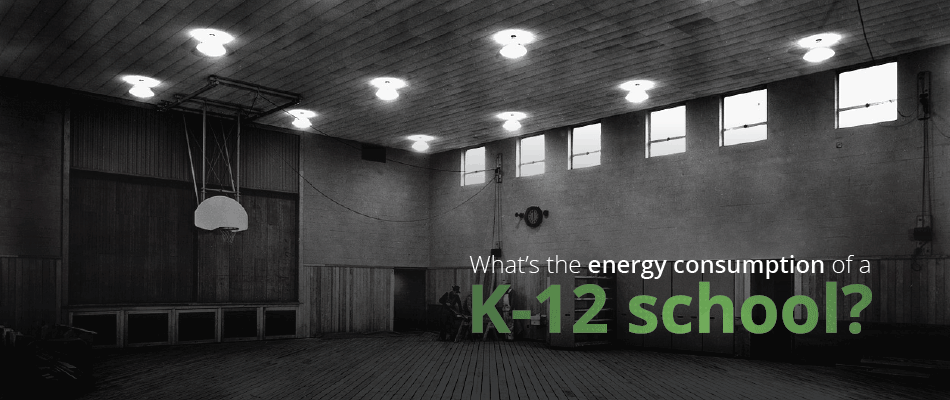Average energy consumption For K-12 schools in Canada
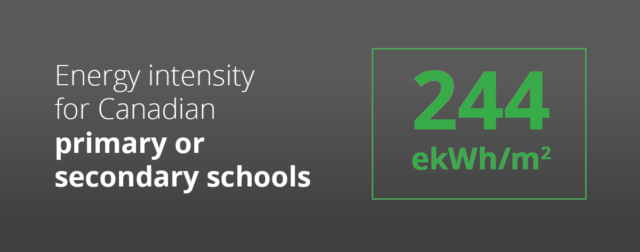
What’s the energy consumption of a K-12 school in Canada?
Short answer: the average is 244 ekWh/m2 (Natural Resources Canada, 2014).
The long answer is more interesting. The variance between Canadian K-12 schools is considerable and the difference in energy consumption between different types of facilities in the country is even more extreme. To compound this variance, Canada’s geographic and climate diversity has a large influence on the consumption. The overall average is on a gradual decline – improved energy efficiency and retrofits are contributing to reduced average consumption.
And even more useful – calculating the average energy consumption of a single K-12 school facility. This value is powerful for two comparisons:
- Compare a facility with a regional average
- Compare a facility with its historic averages
The power of averages is comparing your facility with the other facilities. Here are the averages and how they are calculated.
How energy consumption is measured
The data for a facility’s energy consumption typically come from two sources: the utility provider or the building automation system. Every operational building receives utility bills, so the total consumption and costs is easy to monitor via the utility provider. As building automation systems become increasingly common in K-12 facilities, the monitoring capabilities are extending beyond general consumption and into type, time and quantities of usage.
Reporting requirements from provincial governments (such as British Columbia’s greenhouse gas reporting for public institutions) is extending consumption reporting from voluntary to mandatory.
Standard units for comparing energy consumption are:
- Building Energy Cost Index (BECI): cost/area (such as $/m2)
- Building Energy Performance Index (BEPI): energy use/area (such as ekWh/m2or GJ/m2)
- Energy Use Intensity (EUI): energy use/area (such as ekWh/m2 or GJ/m2)
EUI is effectively the same measure as BEPI – they both normalize energy consumption according to the area of a building. And ekWh (or equivalent kWh) is a unit of energy consumption that is used to convert the volume of an energy source into equivalent energy units. For example, 1 cubic metre (or 1 GJ) of natural gas is 278 ekWh and 1 litre of propane is 7 ekWh.
energy consumption in Canadian schools
As reported by Natural Resources Canada in 2014, the average energy consumption for primary and secondary schools in the country is 245 ekWh/m2 (or 0.88 GJ/m2). Energy Star Portfolio Manager states the average energy consumption is 209 ekWh/m2 (or 0.75 GJ/m2 ).

Energy intensity (ekWh/m2) for Canadian K-12 schools. The area of primary schools is usually under 10,000 square feet and the area of secondary schools is usually over 10,000 square feet. (Natural Resources Canada, 2014)
| School Size | Number of Buildings | Floor Space | Energy Use | Energy Intensity |
|---|---|---|---|---|
| Total | 17501 | 70.8 | 62.2 | 0.88 |
| 5,000 square feet or less (465 square metres or less) | 2947 | 0.4 | 0.3 | 0.7 |
| 5,001 to 10,000 square feet (466 to 929 square metres) | 918 | 0.7 | 1 | 1.33 |
| 10,001 to 50,000 square feet (930 to 4,645 square metres) | 9390 | 27.8 | 25.4 | 0.91 |
| 50,001 to 200,000 square feet (4,646 to 18,580 square metres) | 3973 | 34.5 | 29.1 | 0.84 |
| Over 200,000 square feet (Over 18,580 square metres) | 273 | 7.4 | 6.5 | 0.88 |
(Natural Resources Canada, 2014)
This difference in reported averages is not a surprise. Considering Canada is an extremely diverse country with a dramatic range in climate, the average energy consumption of K-12 school facilities is equally diverse. A 2017 review of the energy consumption of primary and secondary schools in Manitoba calculated the median average of the energy consumption for schools in the province to be 29 per cent higher than the national average. The same study calculated the average for Toronto schools to be 35 per cent higher than the national average.
For the Manitoba facilities, the researchers determined the only factor that had a statistically significant effect on energy consumption was building age. Older facilities tend to consume more energy.
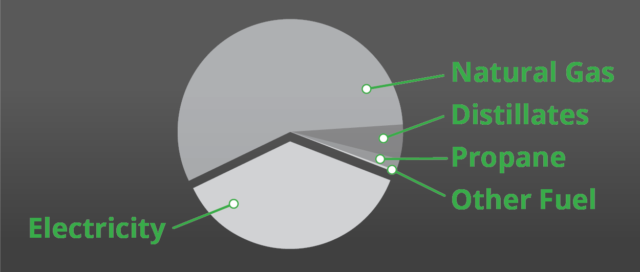
Sources of energy in Canadian schools. The split between electricity and fuel is around 40-60. (Natural Resources Canada, 2014)
Schools compared with other types of facilities
Compared to other types of commercial and institutional facilities, K-12 school facilities have the lowest average energy intensity. Schools with typical schedules are generally occupied between 2,000 and 3,500 hours per year, with half of their use occurring afterhours when custodians are cleaning. School facilities tend to not be occupied 24/7, nor year-round and they are not using energy for manufacturing or storage, so the energy consumption is accounted for by primarily daytime occupation.
Here is the average energy intensity of K-12 school buildings compared to other educational facilities and other types of buildings from Energy Star Portfolio Manager.

The energy intensity of K-12 school facilities compared to other types of educational facilities. (Energy Star Portfolio Manager)
Impacts of climate and Geography
The influence of climate and geography on a facility’s energy consumption is apparent in the average regional energy intensity. The prairie region has the highest average energy intensity in Canada followed by British Columbia.
Here’s the energy intensity by region in Canada from Statistics Canada.
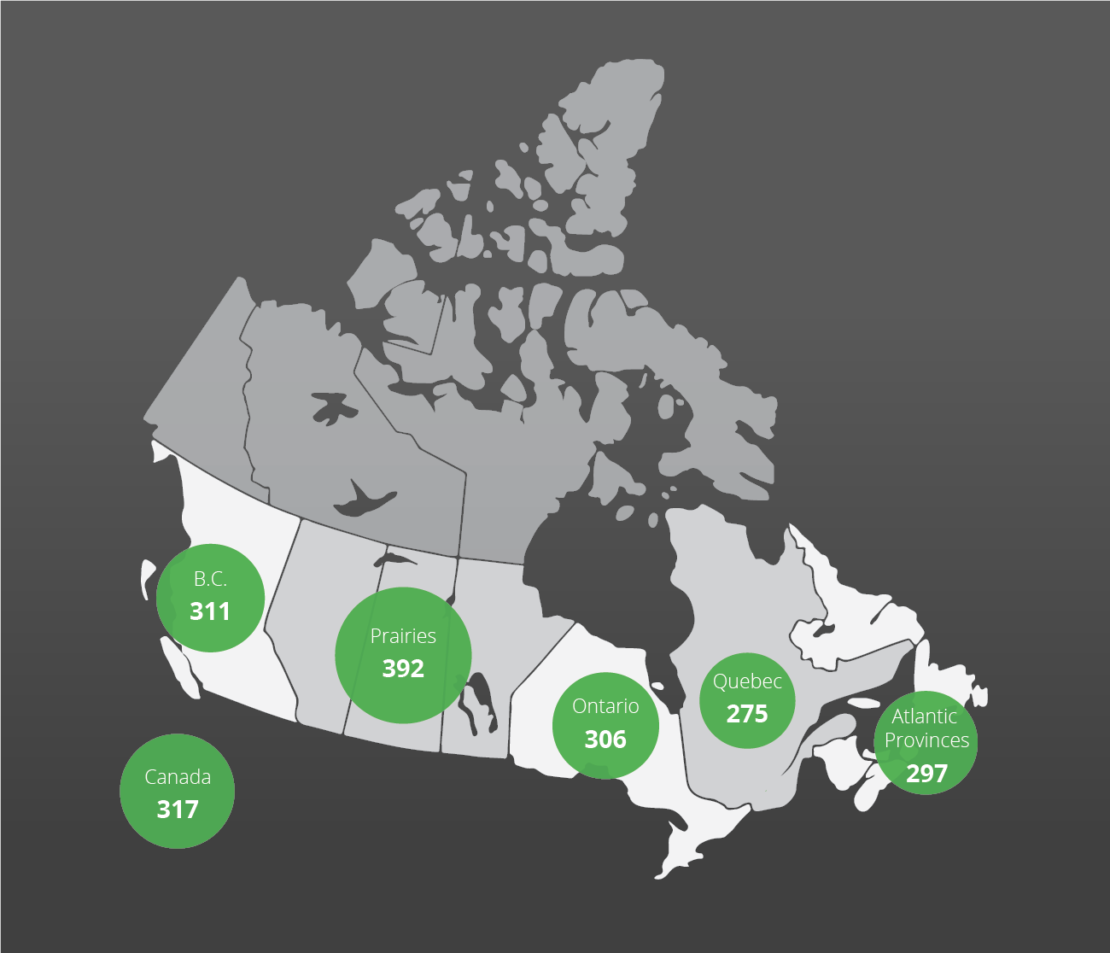
Average energy intensity in Canada by regions. (Statistics Canada)
Canada’s geography and climate has an incredible spread. A school building in Northern Alberta will – not surprisingly – require more fuel to heat the facility than the same building on Vancouver Island. Heating degree-days can assist in comparing energy consumption across different regions.
Heating degree-days is a measure of the number of days that a region has an average temperature below 18˚C. (This target temperature is different around the world – the Canadian standard is 18˚C.) A higher heating degree-days value means facilities in that region are expected to require more heating. Heating degree-days is an indicator of the relative amount of energy consumed for heating facilities.
Integrating heating degree-days with a BEPI provides an energy consumption value that is averaged for the size of a facility and takes into account the local climate. This calculation is the foundation of an energy benchmark.
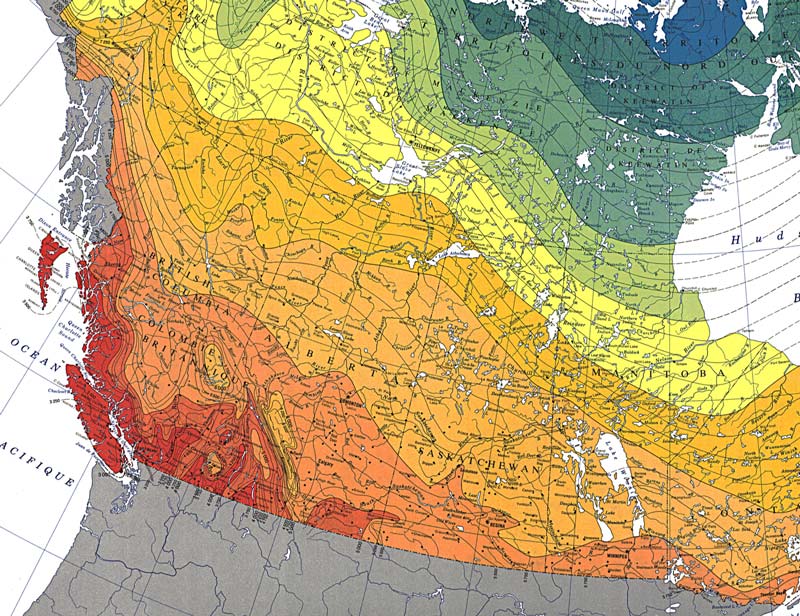
Annual heating degree-days under 18˚C in Western Canada. (National Atlas of Canada)
The future of green buildings in Canada
Energy consumption averages are a baseline to compare future improvements within facilities and regional changes.
The Canada Green Building Council monitors the trends in energy efficiency and the impacts to building design. With the ultimate goal of reducing energy intensity in Canadian buildings, these trends indicate approaches and policies that are being implemented by facility managers (or will be implemented soon).
Energy consumption data through comprehensive building analytics is becoming essential to create strategies for reducing consumption. For facility managers, ongoing reporting and benchmarking can indicate and verify effective approaches and recognizes the cumulative impacts of small changes. Energy accounting is also expanding to include the full costs of energy production and consumption, especially for regional policies or programs.
The future of green buildings does not only refer to new facilities. Retrofits will be necessary to continue reducing energy consumption and carbon emissions. Likewise, effective strategies for sustainability extend beyond mechanical systems and include the awareness and behaviour of occupants.
Reducing carbon emissions is another goal of energy efficiency programs. Although energy efficiency and carbon emissions tend to go hand-in-hand, there are scenarios when improving efficiency does not have equivalent reductions in emissions. If carbon emissions are a deliberate goal, a deliberate strategy may be required.
How much energy does your school consume?
Compare your school’s energy consumption with the national average. Use Rede’s school energy consumption calculator to estimate the energy use and cost intensities.
This consumption estimate is the first step to an energy benchmark for your facility. Use the benchmark to calculate the impacts of energy efficiency projects in comparison with other school facilities and the building’s historical consumption.
Rede’s specialty is understanding energy consumption and data from a building automation system, and then creating action plans and results with that information. With an energy consumption baseline, K-12 school facilities teams can plan for achievable changes and monitor the results.
